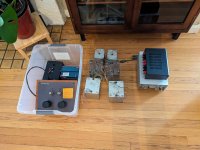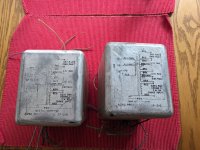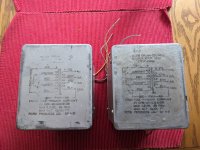Hi,
I had the good fortune of finding a full set of matching Acrosound iron from two Allen 75 (or maybe 90?) amplifiers (the old square Acro cans) at a show today. The chokes say 14hy, 40ma DC, 10V 60 CPS, 50 ohm. They are about 7lbs, so half the size of either the OPTs or PTs (14 lbs each). The Allen 75 schematics I've found show these are input chokes.
I have a couple of George's universal PP driver boards stored, and I'm thinking this will all be a good match. I'd aim for something that spends more time in class A than the original implementation, and I'm puzzled by the size and markings on the chokes. Even biased in the original use, how could 40ma be sufficient? The OPTs are marked for 175ma (These are TO-340/350 sized, but 3.3K rather than a stock model). The only choke input amp I've built was a 6V6 push pull, and despite all the rest of the iron being MUCH smaller, I used a 15lb old Stancor that was rated for LC use.
Does 40ma somehow mean that these things consume 40ma when used as originally intended? That would make sense with the 10V marking that follows it. Or, does it somehow relate to these seeing something quite a bit choppier than the DC you'd get in a CLC supply? The actual Acro schematics I've reviewed (their own 6550 or Williamson designs) show the choke at the 200ma I'd expect.
Sorry for what is likely a stupid question!
Paul
I had the good fortune of finding a full set of matching Acrosound iron from two Allen 75 (or maybe 90?) amplifiers (the old square Acro cans) at a show today. The chokes say 14hy, 40ma DC, 10V 60 CPS, 50 ohm. They are about 7lbs, so half the size of either the OPTs or PTs (14 lbs each). The Allen 75 schematics I've found show these are input chokes.
I have a couple of George's universal PP driver boards stored, and I'm thinking this will all be a good match. I'd aim for something that spends more time in class A than the original implementation, and I'm puzzled by the size and markings on the chokes. Even biased in the original use, how could 40ma be sufficient? The OPTs are marked for 175ma (These are TO-340/350 sized, but 3.3K rather than a stock model). The only choke input amp I've built was a 6V6 push pull, and despite all the rest of the iron being MUCH smaller, I used a 15lb old Stancor that was rated for LC use.
Does 40ma somehow mean that these things consume 40ma when used as originally intended? That would make sense with the 10V marking that follows it. Or, does it somehow relate to these seeing something quite a bit choppier than the DC you'd get in a CLC supply? The actual Acro schematics I've reviewed (their own 6550 or Williamson designs) show the choke at the 200ma I'd expect.
Sorry for what is likely a stupid question!
Paul
I'm not familiar with the Allen amps but my guess is that the chokes are only used to filter the voltages to the input/driver tubes and possibly the screen grids of the output tubes.
Edit: Did some googling and no, it looks lite all the HT passes through that choke. 40mA seems way too low for a KT88 PP amp, especially as it us used in a choke input filter. Perhaps the 40mA DC rating means something else, like a minimum current draw to avoid soaring B+ voltage?
Edit: Did some googling and no, it looks lite all the HT passes through that choke. 40mA seems way too low for a KT88 PP amp, especially as it us used in a choke input filter. Perhaps the 40mA DC rating means something else, like a minimum current draw to avoid soaring B+ voltage?
Last edited:
Congratulations! Sounds like you hit the jackpot. Do you have photos of the cans? Part numbers? It might help identifying what you actually have.
I believe the Allen 75 used a swinging choke at the input to the power supply, with the inductance being 14-16H at a low current of 40ma, and less inductance at higher currents where it will typically operate in that amplifier. The low resistance of the choke and weight tell me that it should be able to handle much more current than 40ma. Chances are good that you bought the original swinging choke that was designed to work in the Allen 75 at full power.
I believe the Allen 75 used a swinging choke at the input to the power supply, with the inductance being 14-16H at a low current of 40ma, and less inductance at higher currents where it will typically operate in that amplifier. The low resistance of the choke and weight tell me that it should be able to handle much more current than 40ma. Chances are good that you bought the original swinging choke that was designed to work in the Allen 75 at full power.
I'd agree that the original schematic identifies the choke as a swinging choke, and someone has subsequently added your chokes' spec to a schematic. Your chokes may have additional markings that align with the original schematic (although the copy of that schematic that I have is not clear enough to show the extra choke numbers).
A swinging choke is often rated with an inductance at max rated dc current, and another inductance at say 10-20% rated dc current, although those specs may or may not be at high Vac (choke input application applies high Vac across the choke) and these help the designer assess the minimum dc load current that provides nominal DCV regulation (a lower load current - below the 'critical' current level - causes a rapid rise in output voltage).
The rating of 10Vac 60Hz and 40mAdc relates only to the test condition used to measure 14Hy. They have likely just provided one 'rating' as it is not common to find choke specs measured at high Vac levels as experienced in choke-input supplies. It is highly likely that the choke provides a much higher inductance for say 100-200Vac 120Hz energisation than at 10V 60Hz with 40mAdc, but the high inductance would significantly droop as mAdc increases. One can but assume that the choke is rated for max nominal DC current in that amp, which for a 6550 UL PP could get up to say 200-250mA. The choke DCR or 50 ohm also aligns with a fairly low 3W dissipation at 250mAdc, given the physical size of your chokes.
A swinging choke is often rated with an inductance at max rated dc current, and another inductance at say 10-20% rated dc current, although those specs may or may not be at high Vac (choke input application applies high Vac across the choke) and these help the designer assess the minimum dc load current that provides nominal DCV regulation (a lower load current - below the 'critical' current level - causes a rapid rise in output voltage).
The rating of 10Vac 60Hz and 40mAdc relates only to the test condition used to measure 14Hy. They have likely just provided one 'rating' as it is not common to find choke specs measured at high Vac levels as experienced in choke-input supplies. It is highly likely that the choke provides a much higher inductance for say 100-200Vac 120Hz energisation than at 10V 60Hz with 40mAdc, but the high inductance would significantly droop as mAdc increases. One can but assume that the choke is rated for max nominal DC current in that amp, which for a 6550 UL PP could get up to say 200-250mA. The choke DCR or 50 ohm also aligns with a fairly low 3W dissipation at 250mAdc, given the physical size of your chokes.
Thanks, all! One more question ... Lets say I want to add a first cap and raise the voltage a bit. Any downside to using a swinger in a CLC? I have another pair of bigger chokes on the shelf, but keeping this set together seems right.
Pics for the curious, but you'll have to settle for the chokes pictured upside down in the whole haul. I'm busy now enjoying that Welborne battery powered pre with its Electra-print opts!
Paul
Pics for the curious, but you'll have to settle for the chokes pictured upside down in the whole haul. I'm busy now enjoying that Welborne battery powered pre with its Electra-print opts!
Paul
Attachments
OPT with 40% turns UL (16% impedance loading) was textbook for 6550's.
Perhaps better to confirm why you may want to alter the original B+ voltage from the default Allen 75 design, to allow some review as to why.
Also perhaps clarify why you want to implement a CLC filter, and what are the conditions. Unless you are specifically designing and testing for some outcome, then any choke will likely 'work' in a CLC filter.
Perhaps better to confirm why you may want to alter the original B+ voltage from the default Allen 75 design, to allow some review as to why.
Also perhaps clarify why you want to implement a CLC filter, and what are the conditions. Unless you are specifically designing and testing for some outcome, then any choke will likely 'work' in a CLC filter.
The short answer for "why" more B+ is anticipated performance, leveraging existing work (I've seen posts about George setting up the UPP board to run 6550s hotter), and because despite that, I like to make things hard. (My previous choke input experience was absurd, in that I took Eli's very carefully conceived El Cheapo design and turned it into a two-chassis monster with parts sourced from Craigslist, Hamfests, and contributions from local forum members (thanks, Zero Cool!)).
The Allens are unusual for organ amps. You can see the 20hz-20khz -1db rating, whereas other makers didn't worry about the top or bottom octave. But, they are also designed in an industrial manner, so seeking some efficiency (less of the class A than we'd usually do here) and reliability (if I'm remembering correctly, the 90s might have some redundant parts?). For example, I assume the 3300 ohm primaries are a bit less expensive to produce, or at least, a touch easier to get to the same power levels than the higher impedance primaries on the "off the shelf" Acros (340/350). I'd hope to leverage the parts oriented a bit more to audio.
I'd certainly ponder historic preservation if these were complete units, but since they are already divorced from their original chassis, that cause is lost.
No need to worry about it now. My queue of projects is deep. And I expect I may get more B+ anyway with modern US line voltage and maybe asking the PTs to light fewer tubes. So, if and when this build comes to be, I'll probably try straight choke input first, see where things settle, and then try some smaller caps in front of the choke if I'm feeling adventurous.
Thanks again!
Paul
The Allens are unusual for organ amps. You can see the 20hz-20khz -1db rating, whereas other makers didn't worry about the top or bottom octave. But, they are also designed in an industrial manner, so seeking some efficiency (less of the class A than we'd usually do here) and reliability (if I'm remembering correctly, the 90s might have some redundant parts?). For example, I assume the 3300 ohm primaries are a bit less expensive to produce, or at least, a touch easier to get to the same power levels than the higher impedance primaries on the "off the shelf" Acros (340/350). I'd hope to leverage the parts oriented a bit more to audio.
I'd certainly ponder historic preservation if these were complete units, but since they are already divorced from their original chassis, that cause is lost.
No need to worry about it now. My queue of projects is deep. And I expect I may get more B+ anyway with modern US line voltage and maybe asking the PTs to light fewer tubes. So, if and when this build comes to be, I'll probably try straight choke input first, see where things settle, and then try some smaller caps in front of the choke if I'm feeling adventurous.
Thanks again!
Paul
The Allen 90 (and 75) were afaik designed and originally built by Webcor/Webster Electric - there would appear to be a lot commercial manufacture interaction as the 1950's rolled on, with Allen bringing items like its amps in house. Given they were mass manufactured, I'd suggest there was quite a bit of design and performance spec effort put into such products, and the part ratings reflect that.
I'm sure some organ makers were about lowest cost, as the 1950's into the early 1960's were increasingly difficult sales times, with the 'boom' in home organs somewhat waning and moving more to diy kits, and the cheaper solid state aspects of design were encroaching fast. In-house manufacture of parts was an important cost aspect, especially if facilities were available/under-utilised - perhaps lots of commercial reasons not to use what now may be viewed as enticing Acro parts.
Certainly a benefit of starting with choke-only filtering is a lower B+ to confirm ok operation, and then retrofitting of a smallish input cap to modify B+ is somewhat simple, assuming all the amps' cap voltage ratings are ok with that, and you know what the original operating conditions actually are. You also have the option of retrofitting a ripple trap cap across the choke if its benefits are worthwhile.
As with any used parts, it can be to your benefit to initially test the parts before committing too much on them being 'good', as subtle things like insulation resistance and a shorted turn can often disguise themselves up until final amp testing.
I'm sure some organ makers were about lowest cost, as the 1950's into the early 1960's were increasingly difficult sales times, with the 'boom' in home organs somewhat waning and moving more to diy kits, and the cheaper solid state aspects of design were encroaching fast. In-house manufacture of parts was an important cost aspect, especially if facilities were available/under-utilised - perhaps lots of commercial reasons not to use what now may be viewed as enticing Acro parts.
Certainly a benefit of starting with choke-only filtering is a lower B+ to confirm ok operation, and then retrofitting of a smallish input cap to modify B+ is somewhat simple, assuming all the amps' cap voltage ratings are ok with that, and you know what the original operating conditions actually are. You also have the option of retrofitting a ripple trap cap across the choke if its benefits are worthwhile.
As with any used parts, it can be to your benefit to initially test the parts before committing too much on them being 'good', as subtle things like insulation resistance and a shorted turn can often disguise themselves up until final amp testing.
- Home
- Amplifiers
- Tubes / Valves
- Capabilities of Acro/Allen 75 chokes


